
|   |

|   |
Srijani festival at Shilpagram in Santiniketan - Tapati Chowdurie e-mail: tapatichow@yahoo.co.in September 9, 2014 Eastern Zonal Cultural Centre under the new director Om Prakash Bharati held a grand festival at Srijani Shilpagram in Santiniketan. Though classical dances and music as well as Rabindra Sangeet were included in the festival, the main focus of the Mahotsav was on tribal and folk dances and its music. The Ministry of Culture, Government of India, seems to have at last woken up from its deep slumber and general apathy for these people who have their unique culture besides the mainstream culture of the country. And it is worthwhile to give as much attention to folk culture, which is rooted to the soil, as it is to the classical traditions of the country. What better venue could one choose for this festival than Shilpagram, which is close to Dwaronda, a home to a number of tribes. It is not unknown that a large number of the Indian population consists of the tribal people. The culture of the tribes of India and their traditions and practices are all pervading in the Indian civilization. These different tribes lead their isolated lives in different parts of the country, especially the seven states of North Eastern India. Their rituals, cultures, beliefs and above all, the harmony with which they survive amidst nature is remarkable. There is a perfect relationship between them and nature and they do nothing that disrupts the ecological balance. The Srijani festival of tribal music, dance, and theatre held in Tagore’s Santiniketan provided a brief glimpse of tribal culture, their lifestyle, costumes and attire, their agricultural skills and so on. Hordes of them from different tribes came happily to the venue to present their music, dance and theatre. The Mahotsav highlighted aspects of folk dance and music. Puppet shows, classical music and dance, a crafts fair and an exhibition of folk music instruments provided a mixed fare. The selection of Niranjan Goswami, director, Indian Mime Theatre, to inaugurate the event was most appropriate. The craft mela where the Baul singers – wandering minstrels - dressed in saffron coloured loose outfits roamed around and sang freely strumming on their ektara (single stringed instrument), songs such as the one below were something to be seen, felt and enjoyed. Everyone asks: “Lalan, what's your religion in this world?” Lalan answers: “How does religion look?” I've never laid eyes on it. Some wear malas (Hindu rosaries) around their necks, some tasbis (Muslim rosaries), and so people say they've got different religions. But do you bear the sign of your religion when you come or when you go?” Their songs in their native, unpolished colloquial language, with profound spiritual and philosophical ideas, provided a glimpse of the rich cultural heritage of the country. There was a Baul Manch at Shilpagram, where they sang and danced with a crowd around them during all parts of the three day festival. Rabindra Sangeet singers were there too. Not to be missed was Manipur’s Nat Sankirtan. Gouranga Leela performed by Brindasabi Devi was highly appreciated. Kirtania Harekrishna Halder, his wife and two daughters kept the audience glued to their seats with their spirited singing. 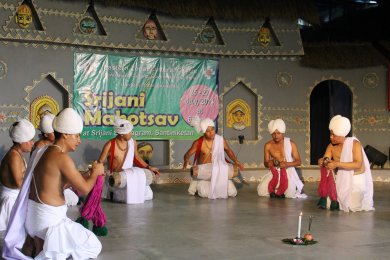 In the Maruni dance of Sikkim, a man dressed as a woman and encircled by women folk, who jest with him and dance joyously, was a simple joy and people laughed a laugh that was truly invigorating. The Nepali community usually breaks into dance in their colourful costumes and bright shining jewels during festivals and other joyous occasions. The Maruni dancers did a lot of acrobatics with their drums and it was a jaw-dropping experience. In the Rauth Nacha of Chattisgarh, the Yadava clan, who pride themselves as the descendants of Sri Krishna, performed a dance that was like raas leela. 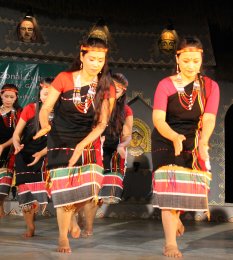 Dancers from Zila Mungeli of Lalpur performed Govardhan Lila. As the legend goes, in the Dwapara Yuga, people were once making huge preparations for their annual offering to Indra, the deity of thunder and storm. On knowing this, the boy Krishna impressed upon the people the futility of sacrifices to stop natural phenomena. Angered by this, Indra caused a deluge for seven long days, upon which Krishna lifted mount Govardhan to shelter men and cattle. Indra accepted defeat. The dancers who were all male, wore red headgears and had sticks in hand, held up to show a mountain. It was a magnificent performance. The tribes, in their own way, manifested the evolution of thought. Wearing colourful costumes, the Maos performed Asha Ralli Odo, composed by Guru RH Daikho. The dancers were from various dance institutions, mainly from Progressive Artists Laboratory and Guru Abhunhal Dance and Music Centre. Malwa’s Matki Lok nritya was a colourful and joyous ‘Mach’ dance which is three centuries old. The bride has lost her chain and bids her brother to find it. A line of girls held umbrellas - a symbol of the people of Malwa - while others told the story through singing and dancing. Kajri of Bihar sung during Sravan celebrates romanticism, the reigning feeling of the monsoon. Songs of longing represented the season. A group of young girls brought Kajri of Bihar to the audience. 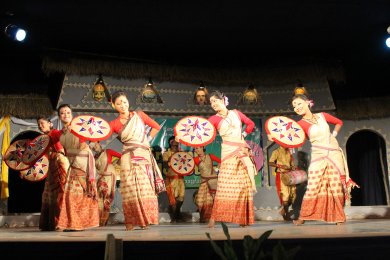
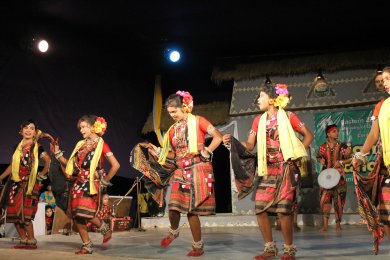
Bratachari or Raibense of ancient Bengal is a reminder that Bengal was a military power. Raibense is a living tradition of war dances in Bengal. “Rai” means king and “bansh” means bamboo. Men who wielded the “bansh” for the king were used as infantry soldiers in the middle ages. Raibense is a valorous dance of ancient Bengal. The main instruments used in this are the dhol and the kanshi which generated daredevilry. There are no songs or lyrics penned by poets for this dance form. The audience saw and heard this martial art form with its loud and vigorous yells after each section, giving them energy to move on. These dances are generally performed by the Bagdi, Bauri and Dom communities of Bardhaman, Birbhum and Murshidabad districts. Daikhai and Rasakali are folk dances of Odisha, more popularly known as the folk dances of Sambalpur. Bhumali is also unique to Bengal. The people of Cooch Bihar perform it during happy times such as Annaprasan, baspuja and marriage ceremonies. Shehnai is used to welcome guests. The chakmas of Tripura perform Bizhu dance - their most popular dance - during Chaitra Sankranti, which marks the end of the Bengali calendar year. New Year’s welcome dance was performed by Sangeeta Khisha who showed us what Bizhu dance is. Of the three kinds of Bihu, the dancers at the Srijani festival performed Rongali Bihu with the accompaniment of dhol, pepa, gagana and toka. Kushan, yet another folk dance of Assam performed by female dancers when they are drunk with ‘haria’ (a local brew) was danced in a lighter vein. Santhali Sohrai dance, the traditional dance of Dwaranda village of Santiniketan, was shown in its pristine form. 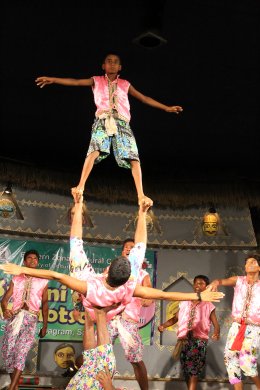 The tribes celebrate their joyful moments through song and dance. Dance for them is not meant for the proscenium stage. It is a part of their life. They have dances to suit events and do not need the presence of onlookers to appreciate them. Thus they celebrate a good harvest, marriages, the birth of a child and tell stories through dance movements. Then we had Manipuri classical dancer Surajit, a student of Guru Babu Singh, dance Dasavatar from Geeta Govindam. He struck a good rapport with the audience and seems to have a grip over the style. Kathak dancer Tamalika Dey, a disciple of Luna Poddar, acquainted the audience with the rich technicalities of Kathak through teen taal. In thumri “Ajo Khele holi” the young dancer showed the exuberance of the festival of colours. Young Odissi dancer Sriradha Paul did an abhinaya piece “Na ja jamuna.” The dance was full of meaningful imagery rendered with care. The director Om Prakash Bharti was totally involved with the task he had taken upon himself. He not only provided a platform for as many young artists as he possibly could, he also penned the play ‘Nirban’ for them to boost them up. The festival’s objective to provide a brief peep into the socio-economic, cultural, spiritual life of these people to see and study our roots and set up a future plan, was amply fulfilled. The world of the tribal people proves that life can be happy even without the help of modern technology. Tapati Chowdurie learnt dance for almost 10 years from Guru Gopinath in his dance institution Natana Niketan in Madras. For a brief period, she was with International Centre for Kathakali in New Delhi. Tapati has a Master's degree in English Literature and Bachelor's degree in Education. She has a regular column in The Statesman, where she writes on dance and music. She also writes for The Hindu and Sruti. Presently, she is a freelance writer. |